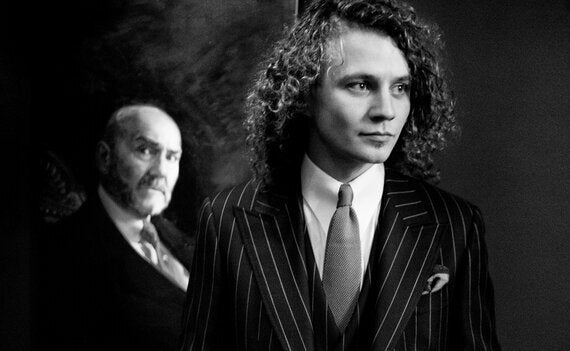It makes sense to exhibit this kind of art in one of Soho's more rebellious corners. The space chosen by Vermilion Hook lies beneath Marshall Street in the basement salon belonging to designer and tailor, Mark Powell.

Sean Rohr, alongside Luke Francis Haseler (pictured), founded the art collective in response to a perceived malaise within the British art world. "A lot of critics are now disillusioned with the YBA [young British artist] generation," says Rohr at the inaugural launch party of The Wine-Dark Sea: Memory and Painting in Drawing. "They can see that a lot of it was hype. Much of modern art will not stand the test of time."
But why use Mark Powell's salon and not a more capacious appointment in Fitzrovia? "In Mark's work as a tailor you can see the pride he takes in his craft. There's a correlation between that and his attitude to art."
Perhaps what also attracted Vermilion Hook to Powell is his independence, a man working tangentially to the world of Savile Row.
"Right now we want to write the rules of the game," adds Rohr, "and we don't like the rules that have been written by the galleries. Vermilion Hook is a visual arts collective. People respond to visual art viscerally, which is the opposite of the response they have to conceptual art.
"Our focus is on curation and ensuring that our body of work is strong. We are not chasing profit, so this means that we will find it hard to stay afloat in the long term, unless we have private patronage or funding. We're doing this because we don't like the art that is out there."
Vermilion Hook exhibit independently by procuring their own spaces in order to retain full creative control over the gallery interior and its curation.
"We want to associate ourselves in a broader sense, with craftsmen like Mark," says Haseler. "I'm not bothered by the lack of capital out there for investment in artists. I want to build relationships.
"I wouldn't call myself an artist at this point. To be called an artist is the greatest compliment and it is thrown around carelessly. It is a distinction that can only be tested by time, by posterity. For the time being, I am a craftsman."
Mr Powell has also sat for Haseler, who painted his portrait (pictured) over a period of three months. The Powell oil hangs in one corner, its Dorian Gray eyes menacing the room.
This is a collective of considerable talent and accomplishment which belies the artists' years, but what sets Vermilion Hook apart from others of a conceptual bent is their return to a traditional skills set.
"We don't play by a set formula," says Haseler. "We have a love of an art that has been and gone. That is, where expression and craft were married in the nineteenth century. But we don't want our work to be disillusioning. If it's unsettling, so be it."
Rohr is keen to finesse the collective's ideal. "We are not diametrically opposed to contemporary art, but we have a lot of misgivings about it and don't think it can accommodate what we want to do at the moment. I don't want this exhibition to be a masturbation of technical facility."
That will be a tricky accusation to fend off in ultra-hip London where false modesty is the order of the day. "A lot of people have come to us and asked why hasn't this been done sooner," adds Rohr, "and it's a very valid question."
The answer perhaps lies in how the art world tiptoes from one fad to the next, the cant written by the usual scribes and TV talking heads, the cant at pains to aggrandise and flatter, rather than to criticise.
The art of criticism itself is dying, with the solitary Brian Sewell a lone voice of contestation set apart from a cringing art elite. Indeed, the Turner Prize may well focus welcome attention upon the art scene, but it still remains a scene too closely associated with the fairground attractions of pickled sharks and frozen blood heads.
Rebellion is in the air, but as ever, an infusion of capital is required to make viable this return to progress. But these young artists won't go cap in hand, but rather pressed suits to the fore. There is, after all, the small matter of pride in one's work.
For more information, click here
Photograph by Betina La Plante
